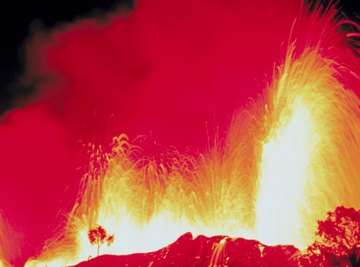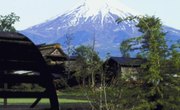
Volcanic eruptions are the result of convection currents, which are repetitive actions that occur underground. As pressure builds beneath the surface of the Earth, it pushes rock sediments upwards, releasing molten rock. Otherwise known as lava, this released material can reach temperatures as high as 2,000 degrees Fahrenheit.
Volcanic Convection Currents
Volcanic convection currents are the reactions to the heat energy within the Earth's core causing a repeated rise and fall of Earth's properties. Image a glass cylinder that uses a candle as its heat source; the molecules at the bottom of the cylinder heat first, rising to the top where they cool and fall back down to the bottom. The movement of the molecules from top to bottom is the convection current. The constant heat causes the same cycle to happen over and over, as convection currents push the liquid material in the volcano's tube toward the Earth's surface.
Tectonic Plate Shifts
Earth has three major layer: the core, mantle and the crust. As convection currents reach the mantel, the heat causes a collision between the continental plate and the oceanic plate under water. The collision causes the two plates to converge, which means that the ocean plate slides downward at a 45 or lesser degree angle. The convection current continues to push the heated magma past the mantel level, reaching the crust of the Earth's surface and producing a lava spout.
Subduction Trench
Convection current movements create a push and pull effect, creating the volcanic trenches, which are formed when two plates collide. The friction between the plates cause one to melt, forcing the other to move downward and leaving a gap. If the magma continues to rise towards the surface of the gap, the formation of another volcano may take place. The entire transformation is so complicated that it takes centuries to develop and complete, which is the reason volcanoes do not just pop up.
Shield Volcanos
Hawaiian volcanoes are shield types, which are flat dome-like shapes with characteristics of calm eruptions. This is the case because the extruded lava is a steady cascade, producing fluid lava flows in stark contrast to an explosive release of lava by other volcanoes. The texture and consistently of the lava allows it to travel over long distances. Volcanologists continue to study volcanoes in great detail, especially shield types which have risen from the ocean floor and continue to expand physical land boundaries.
References
About the Author
Iris McCammon began freelance writing after more than 20 years of experience in the business sector. Her career took her around the world, traveling throughout North America and Europe, managing technical projects for aerospace and government programs. She now writes for several websites on topics of business, culinary arts, local events and travel.
Photo Credits
Ablestock.com/AbleStock.com/Getty Images
